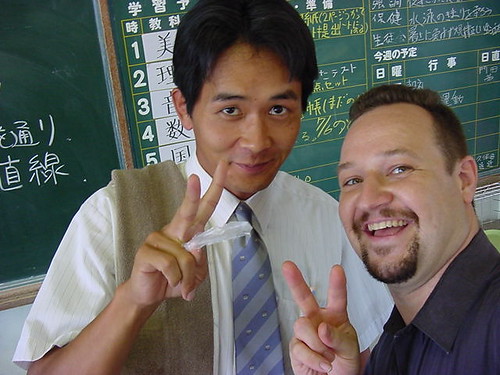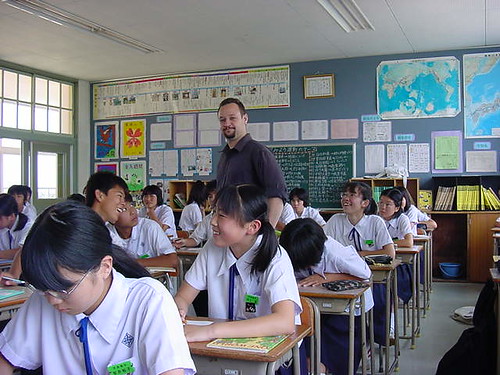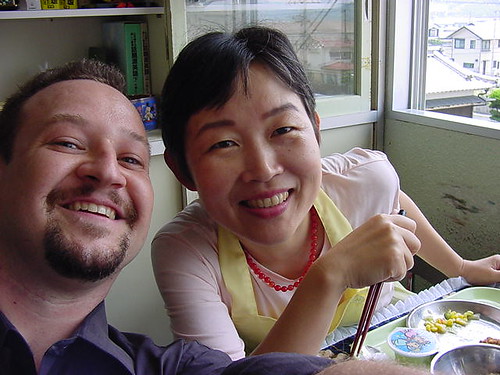What’s your name, when and where was your placement, and where are you from originally?
My name is Michael Dziesinski. I was an Ehime JET who was placed as an ALT in the city of Imabari from 1997 to 2000. Originally from the United States, I was accepted into the JET program during my final year as an Undergrad at Florida State University.
How did you find out about JET, and what led you to apply?
As a major in Asian Studies with a Japan focus at Florida State, I was aware of the JET program from very early in my studies. One great thing about the FSU Asian Studies program at the time was that they heavily promoted study abroad and post-graduation opportunities. One professor in particular had been a JET in the early years of the program and would tell his classes memorable stories about his two years as an ALT. Also, it didn’t hurt that JET representatives made the rounds for information sessions on campus. Personally, with an interest in Japan already, I was either going to apply to grad school to study in Japan or work as a JET. JET accepted me first, so off I went. After my time in JET, I ended up doing grad studies in Japan anyways, but that JET experience became important for my academic focus.
What did you hope to achieve on JET, and did that change during your time here?
For one, even though I had done a study abroad stint a year before my departure as a JET, it was in a structured university program on the outskirts of Tokyo. One aim I had was to get to know the culture and people of Japan better outside of a University setting, to make some genuine connections. Secondly, I hoped that along the way, I’d pick up the Japanese language more naturally and improve beyond my meager two years of University Japanese classes. Third, I was thinking about a career centering on Japan in some way; I wasn’t sure in what way, but I hoped that a stay in Japan would help crystalize that goal.
I’m not sure if JET still has this practice, but JET applicants at the time were asked to write down three places where they wanted to work while on JET. I originally requested places in the Kansai area, with a hope to be placed near Kyoto. Obviously, this didn’t happen. Amongst us Ehime ALTs, we came to the humorous conclusion that JET asked you for your desired placements so they could assign you to the farthest possible location from them! But in hindsight, I was extremely grateful for my time in Shikoku. I’m not sure I could have made the deep connections I did in Ehime if I were placed in a big city like Osaka or Kyoto.
I would say my goals didn’t change so much as they were shaped by the specific local issues and events during my stay. Twenty plus years ago, Imabari City was a very traditional place. As a JET in 1997, you did not get a ‘foreigner card’ as an excuse when you made a cultural faux pas – you were expected figure it out. If you didn’t in a timely manner, someone would pull you aside and point out what you needed to do: after getting boxes (and boxes) of mikan and towels as welcome gifts by teachers, co-workers and neighbors, I didn’t realize at first I was supposed to give gifts in return. After a gentle scolding, I paid closer attention to things like that in Imabari. After JET, I’ve gone on to live another ten years in Japan, from Kobe to Tokyo, but I never quite had the same level of obligation or connection as I did with my Japanese neighbors in Ehime-ken.
Returning back to the subject of improving my Japanese language ability, it was a mixed bag. In 1997, the closest English language sources were bookstores in Matsuyama City, an hour away by train. McDonalds didn’t even open in Imabari until my second year as a JET. Let’s not even talk about how expensive the internet and phone calls were at the time in Japan! So, learning Japanese via immersion was not all that hard to accomplish. I DID improve, but only found out later when studying Japanese again in a class setting that I had picked up an Imabari dialect!
What is your lasting impression of the work you did on JET and the communities you were part of?
One big factor that shaped my personal experiences after I arrived in 1997 was the opening of the Shimanami Kaidō Bridge for the Nishiseto Expressway. Much of our community JET activities centered around the bridge ceremonies in Imabari as well as the neighboring islands in the Seito Inland Sea. These festivals, celebrations, and events really opened my eyes to the broader economic and industrial aspects of Imabari and what the new bridge meant. My Imabari Educational Office was fond of telling me about Imabari’s three big industries: ships, towels, and mikan! But with the bridge opening, what would happen to those ‘big three’ for the area?
My Japanese co-workers and friends were excited about the easy access to the cities of Honshu, but some voiced concerns about the ‘hollowing out’ of communities; that it was now easier for the younger population to move away from Shikoku for good. In the course on my duties as a JET, I attended demonstration lessons at schools around Ehime Prefecture. This concern of ‘hollowing out’ was noticeable even twenty years ago; for example, in one junior high school we had a demonstration lesson that had only nine students – in the whole school – and was scheduled to close permanently. This demographic crisis in the region left a lasting impression on me during my time as a JET. And it wasn’t only the fading schools and local communities, but also the generational loss of traditional skills and crafts due to the migration to big urban centers on Honshu for work.
Where did JET lead you?
As an ALT in Imabari city I encountered several junior high school students at my assigned schools who had become school refusals, tōkōkyohi, due to bullying or after returning from overseas trips. After living for three years in Imabari, I cared about the people in my local community and was troubled on how this could happen to these kids. After JET, I went to graduate school at the University of Hawaii at Manoa to earn a master’s degree in Asian Studies. The focus of my degree was school-to-work and education in Japan. By this time in 2003-4, school refusals were now being called ‘hikikomori’, shut-ins. For my master’s thesis, I lived in Kobe for over a year and commuted to Tokyo to do participant field research as a volunteer at a private rehab center for delinquent youths. There, I studied the rehab of hikikomori into working adults. After missing so much school, many former shut-ins were unable to go to Japanese colleges, so they earned high school diplomas to work in vocational jobs. After my master’s degree, I continued on to earn a PhD in Sociology at U.H. with a dissertation on vocational training in Japan, specifically in the arts and crafts. I did two years of field research in Tokyo at a two-year vocational school for content industry jobs. Planned for three years, it was cut short due to the unfortunate disasters of 3-11. In the years since, then I have worked as a university instructor while I do deeper research into the communities for Japan’s traditional trades and crafting industries in Tokyo and Kyoto – such as in 2016-17 where I connected with master craftsmen in the fields of kimono weaving, woodwork, nō masks, painting, silk dying, and textiles.
Right now, some incoming JETs have been delayed by more than a year and are in the difficult position of choosing to indefinitely wait for Japan to open up or to give up on coming here. Do you have any comments or advice for them during this time?
I understand the frustration of being in limbo, especially when you have just graduated from university and you are trying to consider the next moves for your future and perhaps even your career. In 2011, I was living in Tokyo as a PhD student during the 3-11 triple disaster of the Higashi Nihon Diashinsai. Overseas Universities and Employers suspended all studies and even evacuated foreign nationals back home due to the fear of radiation form Tōhoku. Everything in northern Japan ground to a halt. It took six months for things to return somewhat to ‘normal’ in Tokyo, 150 miles away from Fukushima. Japanese bureaucracy can be slow, but they are also careful. Unfortunately, for those people who left Japan during 3-11, it was very hard to make arrangements to get back to Japan. Some had to wait an entire year to try again for a school program, but many who were employed had lost their jobs in Japan.
My advice is this: The truth is, the JET Program is a job first and foremost. If you walk away from a job offer, it is very unlikely the employer will offer you another position if you come back at a later date. I understand you may be considering graduate school, or even just getting a job right now since you don’t know what’s going to happen with your JET assignment. If you have the ability to wait for Japan to restart JET placements without too much personal sacrifice, do so.
Whatever your original motivations to apply for JET and work in Japan, health crisis notwithstanding, I’m sure your ambitions still remain. The JET experience is worth the wait! It will be a unique experience that you will carry with you (and maybe even treasure). WHEN placements for JET start up again, you will hopefully be in the queue as an accepted JET applicant and be the first batch of ALTs and CIRs to arrive.
If you had been in their position, do you think you would have gone on JET if you’d been in limbo for a year?
In short, yes.
Again, I know first-hand how crushing it can be to get accepted for a program and then, due to events out of your control, the adversity that can follow.
With twenty years of hindsight as a JET alumnus, I say this without exaggeration: living and working in Japan as a JET will stay with you your entire life.
The old adage, “nothing ventured, nothing gained” comes to mind in regard to the opportunity to go to Japan as a JET. It will be well worth the wait.
I know some Ehime JETs from my cohort that ended up settling in Japan or visit regularly even two decades later. Those connections you make as a JET stay with you. JET and Japan has certainly changed over the last two decades since my time as a JET, but I still return to Japan for business and my JET experiences still hold. I went on to live another ten years in Japan after JET and still plan to visit it in the future. Maybe even Kyoto!
To those reading this that were chosen as Ehime-ken JETs but are still waiting for a green light, you have my sincere sympathies in being forced to put your plans on hold due to unfortunate world events. It’ll happen. Just hang in there! Ganbatte!
Michael Dziesinski, PhD
JET Alumnus, Ehime-Ken, Imabari City, 1997-2000

















Leave a Reply